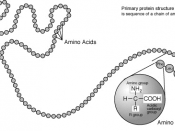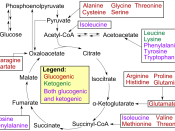Aim:
The objective is to identify specific chemical substances within a cell and to be able to verify the presence or absence of each one in a cell or food substance for future testing.
Hypothesis:
The identification of each biomolecular chemical substance should be verified successfully, as well as determining if it is present or absent in the cell(s).
Theoretical Base:
A biomolecule is a substance that naturally occurs in living organisms. Biomolecules consist primarily of carbon and hydrogen, along with nitrogen, oxygen, phosphorus and sulfur. Other elements sometimes are incorporated but these are much less common.
Biomolecules are necessary for the existence of all known forms of life. For example, humans possess skin and hair. The main component of hair is keratin, an agglomeration of proteins which are themselves polymers built from amino acids. Amino acids are some of the most important building blocks used in nature, to construct larger molecules.
Another type of building block is the nucleotides, each of which consists of three components: either a purine or pyrimidine base, a pentose sugar and a phosphate group. These nucleotides, mainly, form the nucleic acids.
Besides the polymeric biomolecules, numerous small organic molecules are absorbed or synthesised by living systems. Many biomolecules may be useful or important drugs.
Types of biomolecule
A diverse range of biomolecules exist, including:
Small Molecules:
Lipids, Phospholipids, Glycolipids, Sterols
Vitamins
Hormones, Neurotransmitters
Carbohydrates, Sugars
Disaccharides
Monomers:
Amino acids
Nucleotides
Phosphate
Monosaccharides
Polymers:
Peptide, Oligopeptide, Polypeptide, Protein
Nucleic acid, i.e. DNA, RNA
Oligosaccharide, Polysaccharide
Macromolecules:
Prions
Nucleosides & Nucleotides
Nucleosides are molecules formed by attaching a nitrogenous base to a ribose ring. Examples of these include cytidine, uridine, adenosine, guanosine, thymidine and inosine.
Nucleosides can be phosphorylated by specific kinases in the cell, producing nucleotides, which are the molecular building blocks of DNA and...



BIOLOGY NOTES & LAB
GREAT EXPLANATION! THIS IS VERY HELPFUL AND I'M GLAD TO USE THEM AS REFERENCES
0 out of 0 people found this comment useful.